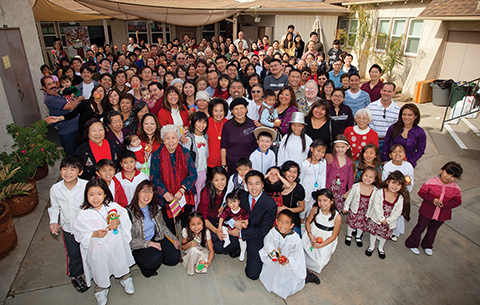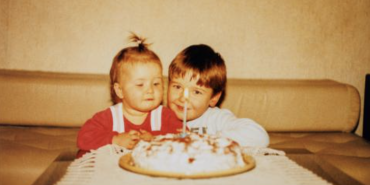Heaven on Earth

Chemistry was one of my favorite subjects in high school. As a curious teenager, the idea of combining different substances without quite knowing how they would interact was both mysterious and exciting. What happens when you burn magnesium in dry ice? Or mix 1,500 ping pong balls with liquid nitrogen? Or combine hydrogen peroxide with potassium iodide? Cool stuff, that’s what! (Go ahead, look it up on Google. You know you want to.)
Growth occurs when a foreign element is introduced into an otherwise static environment. In other words, when we play it safe or fall into routine, we stagnate. But when we step out in faith, that’s when the fun starts. When we try something new, cool stuff happens.
It’s clear from Scripture and history that God is always leading humanity forward. He continually beckons us to get up, leave what is comfortable and familiar, and move toward something better. God is always doing something new, both in us and through us. He has a very specific vision for the human race. The Apostle John gives us a breathtakingly beautiful portrait of this future, as revealed to him by God:
I looked, and there before me was a great multitude that no one could count, from every nation, tribe, people and language, standing before the throne and before the Lamb. They were wearing white robes and were holding palm branches in their hands. And they cried out in a loud voice: “Salvation belongs to our God, who sits on the throne, and to the Lamb.” (Revelation 7:9-10)
Our world is tragically broken. We are divided in just about every imaginable way: politically, racially, socioeconomically, and religiously. But a day is coming when all humanity will be of one mind, one heart, one spirit, and one voice. We will all be reconciled to God and each other through Christ.
The church is meant to be both a picture and a preview of the coming kingdom of God. Our gatherings, therefore, should look and feel like a little bit of heaven on earth.
When you look around on Sunday mornings, what do you see?
Do you see people from every nation, tribe, people, and language worshiping the Lamb of God together? Or do you mostly see people who look and act pretty much like you?
Settling or Reaching Out?
I have the privilege of serving as lead pastor in Los Angeles County. We are both a gateway and a destination for people from all over the world. Our neighbors hail from China, Mexico, Armenia, Korea, the Philippines, El Salvador, India, and just about any other place imaginable. But for many years, our church didn’t reflect this rich diversity.
Our story began in 1927, when a small group of men and women from Los Angeles First Church of the Nazarene began sharing the gospel with the local Chinese population.
They met in basements, markets, and houses, wherever they could find space. Sometimes they even held Sunday school classes in people’s cars. Eventually, these first disciples became a community, then a congregation, and finally a fully organized church. On June 29, 1950, First Chinese Church of the Nazarene was born, a major milestone for our denomination.
By the 1970s, however, the neighborhood surrounding the church had changed significantly. Ethnically, the population had become predominantly African American and Latino. The congregation felt it would have a stronger future if it moved eastward to Monterey Park, where much of the Asian community had relocated.
Once the church moved, it was renamed Trinity Church of the Nazarene, partly out of a desire to be more welcoming to all ethnicities, which was ironic, considering it had just left a diverse community in favor of a more homogenous one.
When I arrived at the church in 2004, it was primarily made up of three large clans: the Wongs, the Lews, and the Ngs. These families—all Chinese—had been with the church from the beginning. Many of them had built the church with their own hands. It took me years to sort out how everyone was related to one another, a task made vastly more difficult by the fact that in Chinese culture, all your elders are called aunties and uncles regardless of whether you are actually related by blood.
The church was faithful, close-knit, and loving, but it had become ingrown and detached from its community. Moreover, the congregation was aging. There were few young adults and families with young children. Although it hadn’t become overly noticeable yet, the church was in the early stages of decline.
We had a choice to make. Would we settle for slow death, content to rest on the foundation laid by those who had come before us? Or would we reclaim our missional heritage and begin a new work, just as our “mother church” had done so many years ago?
Embracing Diversity
We decided on the latter. From the outset, we decided that our church would seek to reflect the diversity of our community. We were ready for God to inject something new into our static environment, knowing it would force us to grow in unexpected ways. It was time to start taking some risks.
Things got interesting pretty fast. We started praying for God to send unchurched people to us, and we prayed that he would send us to them. We expanded our staff and strengthened our children’s and youth ministries. We joined our local Chamber of Commerce as a nonprofit organization. We began caring for homeless families, joined the efforts of our local American Legion post to care for veterans, and threw Christmas parties for children of prison inmates. I underwent training to become a volunteer chaplain with our local police department.
Little by little, we became an active part of our community. Sometimes our plans failed spectacularly, like a chemistry experiment gone wrong. But most of the time, we were delighted at how God answered our prayers and blessed our efforts. And in every circumstance, we grew in faith, wisdom, and experience.
Today, our church is thriving. The nursery is full of babies. We have a fantastic pastoral staff, wise and capable ministry leaders, and an army of faithful volunteers. Our weekly attendance and budget have doubled in size over the past ten years. We’ve launched a Mandarin language congregation as well as a second English service and are considering starting a satellite campus. We’ve raised tens of thousands of dollars for missions, anti-human trafficking initiatives, and clean water projects.
Most importantly, we are beginning to see glimpses of heaven on earth on Sunday mornings. Over a dozen nationalities are represented here, all seeking God together. Half of the men in my discipleship group are of Latino origin. Overall, we are still predominantly Asian American, but our church is increasingly multi-generational, multi-ethnic, and multi-lingual, and we love it.
I’m proud to be part of a denomination that embraces diversity. Our headquarters is aptly named the Global Ministry Center. The flags of every nation in which we have a presence are regularly displayed in front of the building. Revelation 7:9 is embedded in the DNA of our church, its leadership, and its institutions.
If you want to bring new life to your congregation, make room for people who are not like you.
The lessons learned in chemistry apply to the church: when you introduce a new variable into a static environment, cool stuff happens. Lives are changed—including our own.
Albert Hung is the lead pastor of Trinity Church of the Nazarene in Monterey Park, California, a diverse congregation that ministers primarily to the Asian and Latino communities. He has also served as a missionary in Taiwan and as an international chaplain at Azusa Pacific University.
Please note: All facts, figures, and titles were accurate to the best of our knowledge at the time of original publication but may have since changed.




